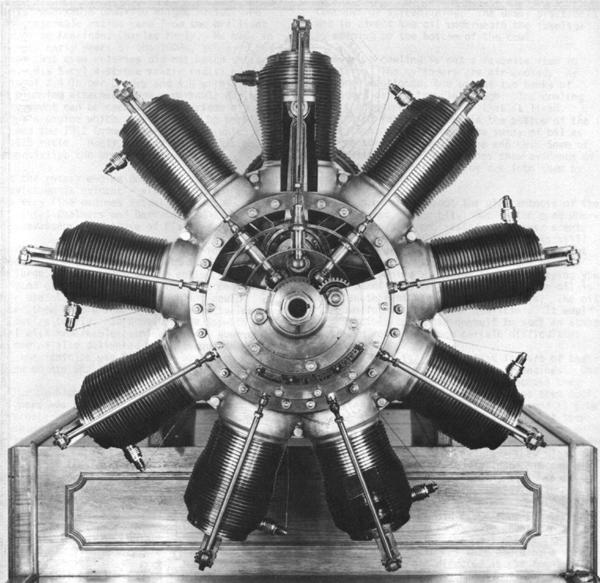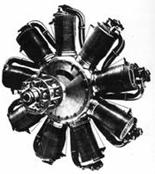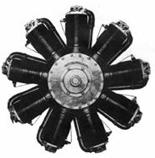| Rotary Engine Theory |

| ||
|---|---|---|---|
| Home Page | Engine Index | ||
 |
|||
| 100 hp Gnome Monosoupape (Photo:The Science Museum, London) | |||
|
Most often attributed to the American F.D.Farwell the rotary engine may have had an earlier beginning in a compressed-air engine worked out by the Australian pioneer Lawrence Hargrave some eight or nine years prior. It is certain, however, that the French brothers Seguin brought the engine into commercial and mechanical life based on the conceptions of one brother (Laurent). It was in 1907 that his 7-cyl rotary was born - and it came to be known as the Gnome. This engine was followed by a succession of designs by many manufacturers, most of which were successful.
We are accustomed to seeing someone swing the prop to start an engine. This was not always necessary because a crank could be engaged to the gear on the rear of the thrust plate and enough rotary motion could be generated to get the engine started. When you compare this with the starting of a radial or an inline the reason why rotaries started easier can be seen. In the case of the radial or inline, it was necessary to set the inards of the engine in motion. The rotary was started by rotating the engine. The mass of the rotary added to the starting function and assisted the effort. The rotary was its own inertial starter! The rotary engine gained quick acceptance because of its remarkable power to weight ratio. The only comparable ratios came from the brilliant mind of an American, Charles Manly. He had, in the very early years of the 1900s, achieved P/W ratios that even rotaries did not match until 1916. His 5-cyl 4-stroke static radial gave a ratio of 2.4 lb per hp dry and 4.0 with all of its plumbing attached. How remarkable was his achievement can be seen in a comparison of the Wright's engine which delivered one hp per 15 lbs and the 1912 Gnome rotary of 80hp which had a 2.625 ratio. Manly did not produce his engine commercially: the brothers Seguin did. That the rotary engine dominated the early years of aviation is evident - although there were some very fine engines extant such as the twins of Duthiel-Chalmers and Darracq, the Antoinette by Levavasseur, and those of Fiat. The demise of the rotary came about for several reasons. Among the most important of these was the large rotating mass of the engine which produced gyroscopic forces. These forces had their useful features - if the pilot could master them before something happened to lessen his desire to fly. It provided the Sopwith Camel with remarkable turning power. However, the engine also delivered sharp torque reversals when the ignition was cut which was tough on the engine mounts and the airframe. Another problem encountered by rotary engine designers was met when trying to meet the demand for greater power. The size of the engine could be expanded in only two directions: make it larger in circumference, make it more than one row (deeper). The problem with the first solution was that this just made the gyroscopic forces even more unmanageable. The second way out of the problem provided much the same effect and the rear bank of cylinders were hard to cool. There are other reasons that would have tended against the use of the rotary into more modern times and the greatest of these would be its enormous appetite for oil. The fuel was mixed with air as it was introduced through a primitive "carburetor" - usually in the tail end of the crankshaft. Via this route it made its way to the crankcase where is picked up all of the oil that was loose. When the fuel mixture was introduced to the combustion chamber it was very much a mix of fuel, air, and castor oil. The imperfect combustion of any engine is not equalled by that of a rotary. The castor oil, being the least combustible of the two liquids, was spewed out into the atmosphere. It would be but a short time before the whole of the slipstream area of the aeroplane would be well coated with castor oil. The pilot would be soaking up oil at a fairly rapid rate as well. It is arguable that the reason for cowling the engine had as much to do with trying to control the wildly spewing oil as it was to do with the concepts of streamlining. The usual practice was to direct the oil underneath the fuselage by opening up the bottom of the cowl. However, a cowling is not a favorite item to a rotary. The cylinders are air-cooled. As has been mentioned, the use of two banks of cylinders caused trouble enough. The cowling made the engine much hotter that it liked. The reason for the cutout in the bottom of the cowl, then, was to direct the spray of oil as well as to aid in cooling the engine. Some of the cowlings of WWI aeroplanes show evidence of extra cooling openings being cut into them by mechanics in the field. Many people remark about the pleasantness of the odor of burnt castor oil. Out in the open where one's exposure is contrasted with other scents, it can be an enjoyable sensation. It is still nice if you are saying, "bye-bye" to the pilot before you go back to your mechanic's tasks. But to sit behind an engine that is spraying you with unburnt - as well as burnt - castor oil is quite another matter after a few hours. The oil is known for its purgative qualities. It would be impossible to expose oneself to such an atmosphere and not experience certain difficulties. It is the need for cooling that is part of the reason that pilots 'blipped' their engines. One could not use a throttle on them because they had such great need of motion to keep them cool. That they were allowed to stop to decend is true but the combustion had ceased during that time. (Of course, starting them up again could be an exciting experience. If they were not too loaded with the explosive fuel mixture - they might do just that: explode. If badly loaded in one or two cylinders, the rough running could cause considerable concern before it cleared.) Although the cowling did cause them to overheat, It also allowed them to produce greater power as the air trapped within the cowl was easier to "stir" with the cylinders than would be a stream of high velocity air directed at the front of the engine. They were easy to start by diving to turn the prop - which turned the engine. And they have been known to run with the most awesome damage inflicted on one or more cylinders. There are many stories about the gyroscopic forces and their ability to turn a sorely pressed pilot out of danger. The most engaging terms used to describe the turn of a Camel was said by Dick Day: "Why, it puts both eyes on the same side of your nose!" |


